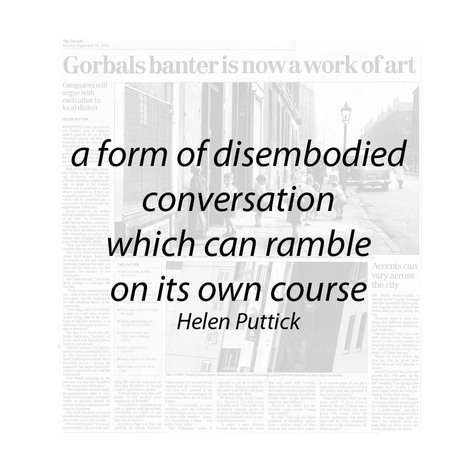The Herald : Gorbals Banter is now a Work of Art
Publication Title: The HeraldWriter: Helen Puttick
Publication Date: 16th September 2002
Residents in the once notorious Gorbals area of Glasgow used to practise the art of conversation leaning out their flat windows, with one eye on children playing below.
Now that the tenements have gone and the 1960s Tower blocks have been demolished, technology is to turn their slick banter into a work of art.
Staff at the Edinburgh University Centre for Speech Technology Research will set up software allowing computers not only to speak in the Gorbals dialect but to respond to each other's comments as if they are engaged in argument Then their voices will be projected into a courtyard to be created under the regeneration of the area.
David Cotterrell, the author behind a number of public works of art, said: "In consultations with various Gorbals community groups, I made a list of ideas and we have decided to come up with something to reflect the banter and language which is part of the Gorbals culture.
"It is one part of the Gorbals heritage they are most proud of."
One of six artists appointed to create focal points, funded by developers in the new Gorbals landscape, believes it is what you hear and not what you see that captures the essence of the community.
Mr Cotterrell said: “This is the third attempt to redesign the Gorbals. ''There is one remaining building, most of the concrete blocks have gone, but the language is the one continual factor in the community.
"One thing about the Gorbals is there is a real sense of communal living. One of the intentions of the new schemes is to make sure that sense of community is preserved."
His idea is to create five different characters, "hybrids" of locals, each with their own likes, dislikes, and attitude.
Gorbals residents will then be asked to help provide their voices. The volunteers will have to speak meaningless sounds into a recording device - giving the computers the range of pronunciations required to talk with the local accent.
New words particular to the area and city may also be added to the computers' dictionary. The computers can then apply pre-programmed rules to construct sentences and to recognise words or phrases uttered by another machine and incorporate them in a response.
The result should be a form of disembodied conversation which can ramble on its own course.
Mr Cotterrell said: "It is quite experimental. I do not think any thing like this has been put out there like this before, so the end result is quite hard to predict.
“I do not know how they will sound. It will involve some suspension of disbelief."
The possibility of people being able to interact with the system, introducing new topics of conversation and modem vernacular may also be built in. Architects Page and Park are working on Queen Elizabeth Square phase D of the new development and Mr Cotterrell's virtual chat will resound in the courtyard they are creating by the community base, the St Francis Centre.
Chris Simmonds, project architect, said the computers would be kept, secure, in a nearby store while speakers - possibly surrounding a bench - will project their natter.
The technology alone is expected to cost up to £13,000, with Miller Homes meeting the bill, and it is not likely to be ready for use until early 2004.
Dr Simon King, of the Centre for Speech Technology Research, said: “This is the first distinctive regional accent of English we have done. There has been precious little work in nonmainstream accents.
"It makes it more difficult because there might be words that are used with Gorbals dialect that are not in our current dictionary and more importantly any pronunciations of words we already have in the dictionary might be very different"
However, he added that the finished voice would "sound pretty natural.”
He said: "The way we made synthesis is recording speech from a person which we then chop up and splice back together in various ways. If you get it right, then it will sound a lot like the person that has recorded it but it will last forever."
Frank McAveety, MSP for the area, said: "I have always believed that the Gorbals has a rich history of those who were great with words, from the Jewish community that settled there and the Irish community that were in the community for many decades."
Dr Jane Stuart-Smith, a lecturer on the English language who has researched Glaswegian, said linguists often assumed the dialect does not vary across the city. However, there is some evidence that different neighbourhoods have their own intonations and vocabulary.
She also said: "Any local area with strong local identity is bound to have some aspects of language which are characteristic - and even if they are not, residents will think they are."
Names of places within the area can also be given local labels which are only familiar to insiders, David Cotterrell has collected phrases like ''I'm goin' up the mols mire for a gam' a best man's fall" meaning "I am going to the swampy land" to play a children's game which involves pretending to fall down dead.
Dr Stuart Smith, of Glasgow University, said she would expect the Gorbals accent to include "a lot of glottal stops" and other pronunciations associated with a strong Scottish ring such as fitba', not football, heid, not head, flair, not floor, hoose, not house, and hame, not home.
Helen Puttick
Read this review here.Download this file here, or click the image on the right.
Share:
Twitter / Facebook / Pinterest
